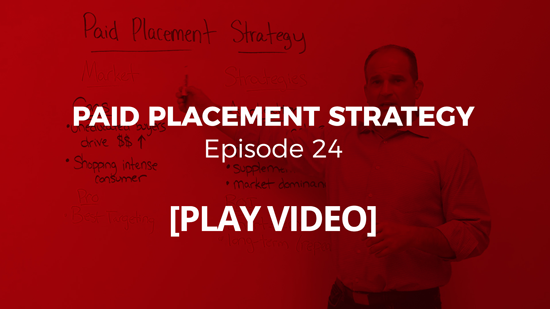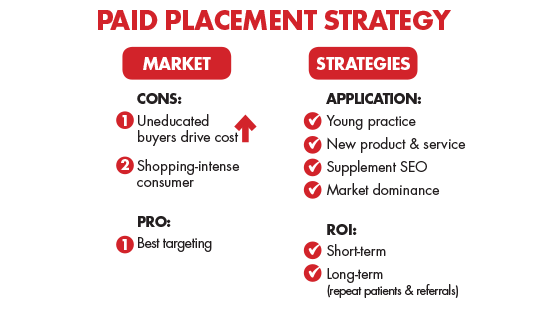The Market
The following are the pros and cons of paid placement strategy in the elective healthcare market.CON – Uneducated buyers
The first thing you should do is consider the market you’re in. In most elective healthcare markets, there are many uneducated buyers. So, whether it be the doctor, office manager, or spouse, these individuals often buy online ads at a price that can’t yield a profitable ROI.
What happens is they get excited about the placement they purchase because they get a few clicks, or they see themselves at the top of the Google search listings, and they’re willing to pay a high amount for that versus paying a high amount to actually acquire a customer.
Because of uneducated buyers, you end up with naturally inflated pricing in many paid placement markets.
CON – Shopping Intense Consumer
The consumer you’re engaging with through paid placement advertising, because of the location of the ad, is generally a more shopping-intense consumer. They’re seeing your ad, and they’re responding. However, if they’re responding that quickly to your ad, they’re probably responding to other ads as well. They’re shopping.
It’s okay – you can make it work, but you should be aware of that and be strategic. We’ve mentioned this in other blogs before, but it bears repeating; with Google paid placement, the average consult attendance rate for a paid placement customer is 55% versus organic search, which is 70%.
That doesn’t mean you can’t make an ROI from the lesser percentage, but you have to figure it into your math and into your strategy.
PRO – Best Targeting Available
Paid placement strategy is the best targeting tool out there. You can buy geographically, you can buy by time of day, you can dictate the price, and you can shoot for certain positions. In most markets, the control you have more than offsets the cons, so it’s a viable opportunity when executed properly.
Strategies
How do you apply this to your personal strategy?
Young Practice
If you have a young practice, you may want to utilize paid placement to get your business going. You should market a variety of procedures and services and be willing to acquire a customer at a lower ROI in order to get your practice up and running.
Use the same methodology for a new product or service. Since you’re willing to go into the market in a very targeted fashion, you may have a lower ROI, but it’s a great way to get things started.
Supplement SEO
You can also use paid placement to supplement SEO. If you’re in a competitive market and you aren’t getting the rankings you want from an organic search on a particular procedure or service that’s important to your practice, you can specifically buy that underperforming organic SEO keyword or term and get yourself up in the rankings.
Market Dominance
If you’re running a practice and you want to be on the offense and absolutely dominate your market, paid placement is a great way to move the competition out of positions and get more exposure for your practice. You can do that at a lower or break-even ROI, but you deflect away from your competition by getting more exposure. Ultimately, you will get the value of repeat business, referrals, etc.
Remember, all of this comes down to your short-term and long-term ROI expectations based on referral or repeat patients. It’s important to consider both of those goals when you start working with paid placement.


















